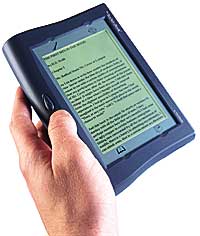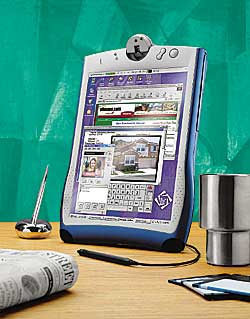 |
History
The idea of creating electronic books in the air for a long time. In fact, this story is a countdown to the 1945 futurist Vanavara That's when Bush first spoke of personal devices, allowing you to store, process and transfer books, records, reports, etc. The next milestone in the development of electronic publishing is considered to be the creation in 1968 . Ted Nelson, hypertext, the cornerstone for the World Wide Web, and, concurrently, the main storage format of the text as the Internet, and in all existing e-books today. In the same student in 1968, Alan Kay has developed a draft DynaBook - portable, interactive computer that performs the role of the book. Unfortunately, the first commercial implementation of this concept remained for twenty years. Three years later, in 1971, initiated by Illinois Benedictine College launched Project Gutenberg (promo.net / pg /) - the largest to date collection of books in electronic format. In 1981, already known Ted Nelson created a group of Xanadu, which had planned to engage in so-called "connected literature" (connected literature) - that is, in essence, that which today are engaged in company-sellers of electronic books. In 1984 appeared the first online magazine FSFnet, which published works of art - his short fiction and fantasy stories. This brings me to the present. In October 1998, almost simultaneously, were issued two devices, which can be in the full sense of the word to name the first electronic book. It is about them and will talk.SoftBook Reader
SoftBook Press www.softbook.com This e-book, something resembling a modern subnotebooks, is positioned as an indispensable attribute of people wealthy, self-confident. At this point, and the cover of leather, and a strict business design, recognized by the way, the best in 1998 And the price-$ 600 (or $ 300 and 2-year subscription service bookstore SoftBookstore $ 20 per month). For a very considerable by our standards, the amount you receive virtually full-featured PC. |
Rocket eBook
NuvoMedia www.rocket-ebook.com This product is more democratic as the design (as the prize in 1998), and price ($ 200). But the possibility of "Rocket eKnigi" modest. This unit focuses on a slightly different market and is more suitable for young people: students, pupils, etc. The book, reminiscent of the modern PDA, the size of slightly less than the standard, weighs 627 g and is equipped with 4 MB Flash-memory, enough to store 3,200 pages. Liquid crystal display (11,4 x 7,6 cm) sensitive to touch and built-in battery lasts for 40 hours of continuous operation without illumination (recharge time 1 hour). There is also a "bulk" version of the book, Rocket eBook Pro, equipped with 16 MB (15,200 pages) of internal memory, expandable to 32 MB. For working Rocket eBook you need a computer. Downloadable files from the Internet (the official RocketLibrarian Library is located at www.rocket-library.com) transferred to the book through the serial port. Of course, this approach allows us to reduce the cost of the device (due to exclusion of the modem), but complicates the process of uploading texts, and also makes the book tied to the PC. Complete Rocket eBook users are "Alice in Wonderland" and Random House Webster-s eDictionary volume of 75 thousand words, which can be called at any time by using a special button on your books. Other books, as in the case described above, will have to buy, and prices are comparable, but unlike many SoftBook Press materials distributed free of charge. As SoftBook Reader, product specification supports NuvoMedia Open eBook, and therefore allows to include in the text black and white drawings, tables, charts and photographs. To create your own electronic books used RocketWriter, the functional capabilities similar to SoftPress Personal Publisher. In addition, there is a PC-emulator Rocket eBook, which can be downloaded from the company. In the future, developers plan to equip your device color monitor and a port USB.And others
 |
Once again, copyright law
In addition to purely legal issues in copyright e-books, there is still a matter of convenience of use. The use of technical protection measures (software keys, unique codes, etc.) leads to a decrease in the practical value of such publications, the main advantage that - easy information retrieval. This is especially noticeable when using digital libraries, particularly scientific. The situation is complicated by the fact that different electronic publishers use their own encryption and access restrictions. Sources, Materials:Home PC, April 2000.
The authors, translation:
Oleg Danilov